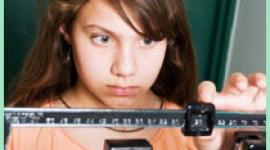Eating Disorders: Self Injury
What is self-injury?
 It's called many things - self-inflicted violence, self-injury, self-harm, parasuicide, delicate cutting, self-abuse, self-mutilation (this last particularly seems to annoy people who self-injure).
It's called many things - self-inflicted violence, self-injury, self-harm, parasuicide, delicate cutting, self-abuse, self-mutilation (this last particularly seems to annoy people who self-injure).
Self-injury is also called the "new age anorexia," the practice of self-abuse or mutilating behavior is on the rise.
Broadly speaking self-injury is the act of attempting to alter a mood state by inflicting physical harm serious enough to cause tissue damage to one's body.
Approximately 1% of the United States population uses physical self-injury as a way of dealing with overwhelming feelings or situations, often using it to speak when no words will come.
The forms and severity of self-injury can vary, although the most commonly seen behavior is cutting, burning, and head-banging.
Other forms of self-injurious behavior include:
- carving
- scratching
- branding
- marking
- burning/abrasions
- biting
- bruising
- hitting
- picking, and pulling skin and hair
It's not self-injury if the primary purpose is:
- sexual gratification
- body decoration (e.g., body piercing, tattooing)
- spiritual enlightenment via ritual
- fitting in or being cool
Why does self-injury make some people feel better?
- It reduces physiological and psychological tension rapidly.
- Studies have suggested that when people who self-injure get emotionally overwhelmed, an act of self-harm brings their levels of psychological and physiological tension and arousal back to a bearable baseline level almost immediately. In other words, they feel a strong uncomfortable emotion, don't know how to handle it (indeed, often do not have a name for it), and know that hurting themselves will reduce the emotional discomfort extremely quickly. They may still feel bad (or not), but they don't have that panicky jittery trapped feeling; it's a calm bad feeling.
- Some people never get a chance to learn how to cope effectively.
- One factor common to most people who self-injure, whether they were abused or not, is invalidation. They were taught at an early age that their interpretations and feelings about the things around them were bad and wrong. They learned that certain feelings weren't allowed. In abusive homes, they may have been severely punished for expressing certain thoughts and feelings. At the same time, they had no good role models for coping. You can't learn to cope effectively with distress unless you grow up around people who are coping effectively with distress. Although a history of abuse is common about self-injurers, not everyone who self-injures was abused. Sometimes invalidation and lack of role models for coping are enough, especially if the person's brain chemistry has already primed them for choosing this sort of coping.
- Problems with neurotransmitters may play a role.
- Just as it's suspected that they way the brain uses serotonin may play a role in depression, so scientists think that problems in the serotonin system may predispose some people to self-injury by making them tend to be more aggressive and impulsive than most people. This tendency toward impulsive aggression, combined with a belief that their feelings are bad or wrong, can lead to the aggression being turned on the self. Of course, once this happens, the person harming himself learns that self-injury reduces his level of distress, and the cycle begins. Some researchers theorize that a desire to release endorphins, the body's natural painkillers, is involved.
What kinds of people self-injure?
Self-injurers come from all walks of life and all economic brackets. People who harm themselves can be male or female; gay, straight, or bisexual; Ph.D.'s or high-school dropouts or high-school students; rich or poor; from any country in the world. Some people who self-injure manage to function effectively in demanding jobs; professors, engineers. Some are on disability. Their ages range from early teens to early 60s.
In fact, the incidence of self-injury is about the same as that of eating disorders, but because it's so highly stigmatized, most people hide their scars, burns, and bruises carefully. They also have excuses ready when someone asks about the scars.
Aren't people who would deliberately cut or burn themselves psychotic?
No more than people who drown their sorrows in a bottle of vodka are. It's a coping mechanism, just not one that's as understandable to most people or as accepted by society ad alcoholism, drug abuse, overeating, anorexia and bulimia, workaholism, smoking cigarettes, and other forms of problem avoidance.
Okay, then isn't it just another way to describe a failed suicide attempt?
NO. Self-injury is a maladaptive coping mechanism, a way to stay alive. People who inflict physical harm on themselves are often doing it in an attempt to maintain psychological integrity - it's a way to keep from killing themselves. They release unbearable feelings and pressures through self-harm, and that eases their urge toward suicide. And, although some people who self-injure do later attempt suicide, they almost always use a method different from their preferred method of self-harm.
Can anything be done for people who hurt themselves?
Yes. Many new therapeutic approaches have been and are being developed to help self-harmers learn new coping mechanisms and teach them how to start using those techniques instead of self-injury. These approaches reflect a growing belief among mental-health workers that once a client's patterns of self-inflicted violence stabilize, real work can be done on the problems and issues underlying the self-injury. Also, research into medications that stabilize mood, ease depression, and calm anxiety is being done; some of these drugs may help reduce the urge to self-harm. What problems may be encountered when getting professional help? Self-injury brings out many uncomfortable feelings in people who don't do it: revulsion, anger, fear, and distaste, to name a few. If a medical professional is unable to cope with her own feelings about self-harm, then he/she has an obligation to the client to find a practitioner willing to do this work. In addition, the therapist has the responsibility to be certain the client understands that the referral is due to the practitioner's own inability to deal with self-injury and not to any inadequacies in the client.
People who self-injure do generally do so because of an internal dynamic, and not in order to annoy, anger or irritate others. Their self-injury is a behavioral response to an emotional state, as is usually not done in order to frustrate caretakers. What problems may be encountered in the emergency room? In emergency rooms, people with self-inflicted wounds are often told directly and indirectly, that they are not as deserving of care as someone who has an accidental injury. They are treated badly by the same doctors who would not hesitate to do everything possible to preserve the life of an overweight, sedentary heart-attack patient.
Doctors in emergency rooms and urgent-care clinics should be sensitive to the needs of patients who come in to have self-inflicted wounds treated. If the patient is calm, denies suicidal intent, and has a history of self-inflicted violence, the doctor should treat the wounds as they would treat non-self-inflicted injuries. Refusing to give anesthesia for stitches, making disparaging remarks, and treating the patient as an inconvenient nuisance simply further the feelings of invalidation and unworthiness the self-injurer already feels.
Although offering mental-health follow-up services is appropriate, psychological evaluations with an eye toward hospitalization should be avoided in the emergency room unless the person is clearly a danger to his/her own life or to others. In places where people know that self-inflicted injuries are liable to lead to mistreatment and lengthy psychological evaluations, they are much less likely to seek medical attention for their wound infections and other complications.
Why do adolescents self-injure?
Adolescents who have difficulty talking about their feelings may show their emotional tension, physical discomfort, pain and low self-esteem with self-injurious behaviors. Although they may feel like the "steam" in the "pressure cooker" has been released following the act of hurting themselves, teenagers may also feel hurt, anger, fear, and hate.
What can parents do about self-injury?
Parents must listen to their child and acknowledge their child's feelings. (In other words, parents should validate feelings - not necessarily the teen's behavior.)
Parents should also serve as role models in the way they deal with stressful situations and traumatic events, in how they respond to other people, by not allowing abuse or violence in the home, and by not engaging in acts of self-harm.
Evaluation by a mental health professional may assist in identifying and treating the underlying causes of self-injury. A mental health professional can also diagnose and treat the serious psychiatric disorders that may accompany self-injurious behavior. Feelings of wanting to die or suicidal plans are reasons for parents to seek professional care for their child immediately.
next: Eating Disorder, Type 1 Diabetes a Dangerous Mix
~ eating disorders library
~ all articles on eating disorders
APA Reference
Staff, H.
(2008, December 22). Eating Disorders: Self Injury, HealthyPlace. Retrieved
on 2024, April 24 from https://www.healthyplace.com/eating-disorders/articles/eating-disorders-self-injury



